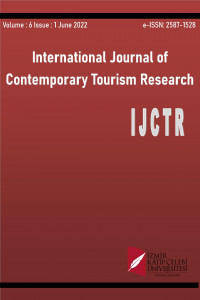Gastronomi Turizmi Açısından Coğrafi İşaretli Ürünlerin Algılanma Düzeyi: Antalya Örneği
Turizmin sürdürülebilirliği yönünde gastronomi turizmi oldukça önem taşımaktadır. Coğrafi işaretli ürünlerin gastronomi turizminde kullanılması turizm ürününü farklılaştırarak yöreye önemli bir çekim oluşturduğu, ekonomik kalkınmayı desteklediği, ürünü, tüketiciyi ve üreticiyi koruduğu belirtilmektedir. Bu çalışmanın amacı, Antalya ili coğrafi işaret alan bazı ürünlerinin gastronomi turizmi yönüyle bölge halkı tarafından nasıl algılandığını bulgulamaktır. Araştırma, Antalya ilinde yaşayan 143 katılımcı ile gerçekleştirilmiştir. Elde edilen veriler anket aracılığıyla toplanmıştır. Gerçekleştirilen alan araştırması sonucunda katılımcılar Antalya ilinde coğrafi işaret alan ürünlerin gastronomi turizmine katkısını ölçen sorulara olumlu yönde cevap verdiği gözlenmiştir. Katılımcıların %40,8’i Finike Portakalı’nın bölgedeki gastronomi turizminin gelişimine en fazla katkı sağlayacağını düşünmektedir.
Anahtar Kelimeler:
Gastronomi Turizmi, Coğrafi İşaret, Antalya ili coğrafi işaretli ürünleri
Perception Level Of Products With Geographical Marking In Terms Of Gastronomy Tourism: Antalya Example
Antalya province of Turkey in terms of tourism is a very important destination. Gastronomy tourism are very important for the sustainability of tourism. It is stated that geographically marked products differentiate the product and create an important attraction for gastronomic tourism in the region, support economic development, and protect the product, the consumer and the producer. The aim of this study is to find out how some products that have geographical indications in Antalya province are perceived by the people of the region in terms of gastronomy tourism. The research was carried out with 143 participants living in Antalya province. The survey was used to collect the obtained data. As a result of the field research conducted, it was observed that the participants responded positively to the questions measuring the contribution of the products that receive geographical indications to gastronomy tourism in Antalya. Participants stated that Finike Orange contributed the most to Antalya gastronomy tourism with 40.8%.
Keywords:
Gastronomy Tourism, Geographical Indications, Products of Geographical Indications in Antalya,
___
- Ab Karim, S. & Chi, C. G. Q. (2010). Culinary tourism as a destination attraction: an empirical examination of destinations' food image. Journal of Hospitality Marketing & Management, 19(6), 531-555.
- DuRand, G. E., Heath, E. (2006). Towards A Framework for Food Tourism As An Element of Destination Marketing. Current Issues in Tourism, 9(3), 206-234.
- Hall, C. M. (2003). Food tourism around the world: Development, management and markets. Amsterdam: Butterworth-Heinemann.
- Jay, T. ve Taylor, M. (2012). A Case of Champagne: A Study of Geographical Indifications. Corporate Governance Journal. 7(15). 1-32.
- Kan, M., Gülbuçuk, B. ve Küçükkongar, M. (2012). Coğrafi İşaretlerin Kırsal Turizmde Kullanılma Olanakları. KMÜ Sosyal ve Ekonomik Araştırmalar Dergisi, 14 (22). 93-101.
- Kivela, J. & Crotts, J. C. (2006). Tourism And Gastronomy: Gastronomy's Influence On How Tourists Experience A Destination. Journal of Hospitality & Tourism Research, 30(3), 354-377.
- Mercan, Ş. O., Üzülmez, M. (2014). Coğrafi İşaretlerinin bölgesel turizm gelişimindeki önemi: Çanakkale ili örneği. Dokuz Eylül Üniversitesi, İktisadi ve İdari Bilimler Fakültesi Dergisi, 29(2).
- Savarin, (2016). Lezzetin fizyolojisi, Oğlak yayıncılık, İstanbul.
- Suh, J., Macpherson, A. (2007). “The Impact of Geographical Indication on the Revitalization of a Regional Economy: A Case Study of ‘Boseong’ GreenTea”, Area, 39 (4), 518-527.
- Teuber, R. (2011). Cosumers’ and Producers’ Expectation Towards Geographical Indication: Empirical Evidence for German case Study. British Food Journal, 13(7), 900-9018.
- Antalya İl Kültür ve Turizm Müdürlüğü, https://antalya.ktb.gov.tr/TR-66213/genel-bilgiler.html; Erişim Tarihi: 29.02.2019.
- Türk Patent Enstitüsü, Antalya ili coğrafi işaretli ürünleri (https://www.turkpatent.gov.tr/TURKPATENT/geographicalRegisteredList/ErişimTarihi: 20.05.2019).
- Türk Patent Enstitüsü, 2019, a) (https://www.turkpatent.gov.tr/TURKPATENT/resources/temp/612D385A-5046-418F-BAFE-E73E5D108530.pdf; Erişim tarihi: 30.07.2019).
- Türk Patent Enstitüsü, 2019, b) (https://www.turkpatent.gov.tr/TURKPATENT/resources/temp/612D385A-5046-418F-BAFE-E73E5D108530.pdf; Erişim tarihi: 30.07.2019).
- Türk Patent Enstitüsü, 2019, c) (https://www.turkpatent.gov.tr/TURKPATENT/resources/temp/8831B367-A7C4-4E72-9CAE-628B14A53F01.pdf; Erişim tarihi: 30.07.2019).
- Türk Patent Enstitüsü, 2019, d) (https://www.turkpatent.gov.tr/TURKPATENT/resources/temp/83679A8A-EE78-46D0-87EE-88F1272545CD.pdf; Erişim tarihi: 30.07.2019).
- Türk Patent Enstitüsü, 2019, e) (https://www.turkpatent.gov.tr/TURKPATENT/resources/temp/9AEFA679-8468-4529-A65F-73E781A1F2E1.pdf; Erişim tarihi: 30.07.2019).
- Türk Patent Enstitüsü, 2019, f) (https://www.turkpatent.gov.tr/TURKPATENT/resources/temp/2C2266B4-080B-495C-A301-79F520E00063.pdf; Erişim tarihi: 30.07.2019). www.matso.org.tr/haberler/manavgat-susami-markalasiyor.html; Erişim tarihi: 01.07.2019
- Başlangıç: 2016
- Yayıncı: İzmir Katip Çelebi Üniversitesi
Sayıdaki Diğer Makaleler
Gastronomi Turizmi Açısından Coğrafi İşaretli Ürünlerin Algılanma Düzeyi: Antalya Örneği
WHEN EUROPEANS TRAVEL: CREATION OF A POST-NATIONAL IDENTITY THROUGH TOURISM
Turizmin Bilimsel Konumuyla İlgili Makalelerin Bibliyometrik Analizi
Büşra ŞENER, Mehmet Halit AKIN
Müze İmajı ve Ziyaretçi Memnuniyetinin Davranışsal Niyete Etkisi: Afyonkarahisar Örneği
Huseyin PAMUKCU, Erdem BAYDENİZ, Canan TANRISEVER, Mustafa SANDIKCI
Konaklama İşletmelerinin İklim Değişikliğine Yönelik Farkındalıkları ve Adaptasyon Stratejileri
